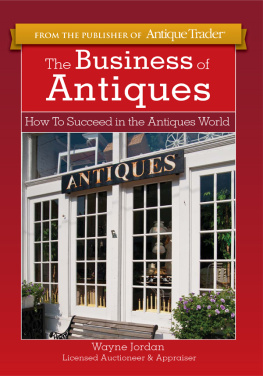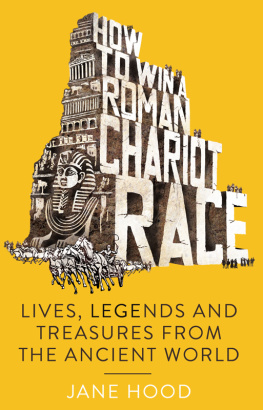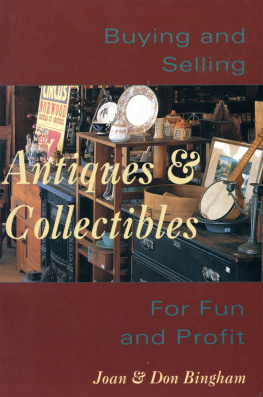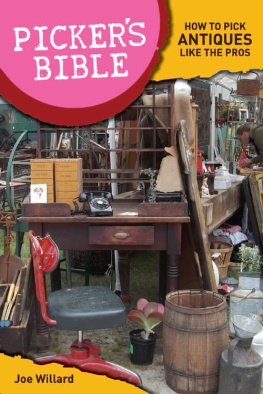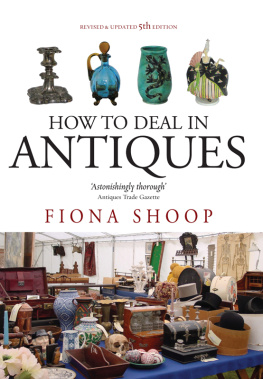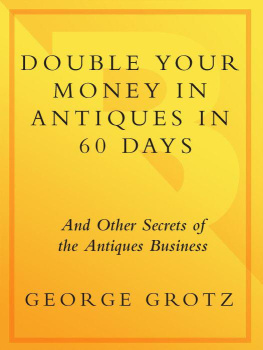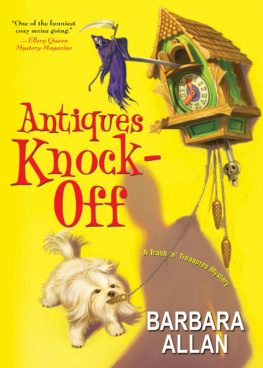Wayne Jordan - The Business of Antiques
Here you can read online Wayne Jordan - The Business of Antiques full text of the book (entire story) in english for free. Download pdf and epub, get meaning, cover and reviews about this ebook. year: 2012, publisher: Penguin Publishing Group, genre: Romance novel. Description of the work, (preface) as well as reviews are available. Best literature library LitArk.com created for fans of good reading and offers a wide selection of genres:
Romance novel
Science fiction
Adventure
Detective
Science
History
Home and family
Prose
Art
Politics
Computer
Non-fiction
Religion
Business
Children
Humor
Choose a favorite category and find really read worthwhile books. Enjoy immersion in the world of imagination, feel the emotions of the characters or learn something new for yourself, make an fascinating discovery.
- Book:The Business of Antiques
- Author:
- Publisher:Penguin Publishing Group
- Genre:
- Year:2012
- Rating:3 / 5
- Favourites:Add to favourites
- Your mark:
- 60
- 1
- 2
- 3
- 4
- 5
The Business of Antiques: summary, description and annotation
We offer to read an annotation, description, summary or preface (depends on what the author of the book "The Business of Antiques" wrote himself). If you haven't found the necessary information about the book — write in the comments, we will try to find it.
The Business of Antiques — read online for free the complete book (whole text) full work
Below is the text of the book, divided by pages. System saving the place of the last page read, allows you to conveniently read the book "The Business of Antiques" online for free, without having to search again every time where you left off. Put a bookmark, and you can go to the page where you finished reading at any time.
Font size:
Interval:
Bookmark:

Wayne Jordan
Lincensed Auctioneer & Appraiser

Its been said the antiques business is the largest unregulated trade in the world, second only to the black market. Its easy to see why: There are few barriers to enter the market (most only need a computer and an Internet connection) and inventory has never been more plentiful; transactions are usually in cash and there exists no national group to speak as one voice for the market.
But it takes a certain knack to be successful at selling high design from past eras. Its easy to see when its lacking: Antiques businesses fail at an alarming rate. The breakneck pace of technological advancements changing this business is coupled with the break-back work to move heavy furniture or set out inventory weekend after weekend at shows. As we chronicle in each issue of Antique Trader magazine (for the last 57 years), successful antiques sellers are a savvy, educated bunch that know their business inside and out. During the last five years, however, that business is changing faster than many can predict or manage.
Enter Wayne Jordan. Wayne and I met in the summer of 2009 to update the skills of the average American antiques dealer. We discussed their most valuable skills this business class had spent a lifetime developing and then talked about how current changes are quickly eroding the relevance and impact of the most important skills. Few resources exist to educate the modern dealer (whose head is also swimming with facts and concepts ranging from fakes and reproductions to the difference between Art Nouveau and Art Deco) and teach them the benefit of search engine optimization, how to post a commercial on YouTube.com or how to sell Victorian furniture to a 20-something IKEA disciple.
Waynes approachable, never condescending, and easy-to-read columns quickly became a hit among readers. Readers appreciate his practical advice, point-by-point descriptions, and his background (Hes an experienced auctioneer and personal property appraiser: read, been there, done that.).
Our readers are succeeding and staying in business and, rather than finding themselves wondering what they will do to make their business grow next year, they are surfing on the waves of change rather than drowning in it.
Most valuable of all of Waynes most successful tools are his flexibility and energy. It rubs off on you: Hey, if Wayne can create a Google Places ad or create better direct mail cards and build a business for the 21st century, then so can I.
And you will with this book.
Eric Bradley
Editor
Antique Trader magazine
Why You Need This Book

In 1993, Encyclopedia Britannica had the most profitable year in the companys history. Two years later, the company was nearly bankrupt and was sold for below book value. What happened in those two years?
Most folks would say that Britannica was done in by Microsoft Encarta. In 1993, Microsoft purchased rights to the Funk & Wagnalls Encyclopedia, created an electronic version, changed the name to Encarta, and began bundling Encarta with new computers. Encarta could be purchased off-the-shelf for around $50. Britannica sold for around $1,200. Competition from Encarta killed Britannica.
Or did it?
Did the fact that Encarta was faster, more accessible and cheaper kill Britannica or was something greater at work here? My contention is that there was something greater at work: a paradigm shift. By paradigm shift, I mean a complete change in thinking or belief system that allows the creation of a new condition previously thought impossible.
Microsoft approached Britannica in the late 1980s regarding the Encarta project, but Britannica declined to become involved. Britannica felt that involvement in an electronic encyclopedia would hurt print sales. It never occurred to Britannica that Encarta could wipe out their print sales entirely. The public experienced a complete change in thinking about encyclopedias. For slightly more than the cost of a set of encyclopedias, a family could buy a computer with an encyclopedia. The world was moving away from the library and into the den. Britannica didnt see the paradigm shift in their industry.
In America today, there is a paradigm shift occurring that will completely restructure the antiques business. What are the main drivers of the new paradigm? There are two: a soon-to-be crushing overabundance of supply and universal distribution.
Lets start by examining the supply issue.
Currently, there are seven generational cohorts in America. For our purposes, a cohort can be defined as a group that wields economic power. The largest cohort is the Baby Boomers group. Currently, Boomers are acting as caregivers and executors for their parents generation, the Builders. Builders, for the most part, did not collect antiques; consequently, Boomers inherited the household goods of their grandparents and parents. Boomers are avid collectors of everything. Having grown up on stories of the Great Depression and wartime sacrifice, Boomers as a generation take great pride in their material possessions. There are more antiques and collectibles in private collections than in all the antique stores in America.
As a result of population shift, there is a tsunami of supply on the way. In 1995, the death rate in America was about 8 per 1,000. These are the Builders being laid to rest.
Most of their antiques and collectibles went to their children, the Boomers. But, by 2016, the death rate in America is predicted to be 26 per 1,000. The death rate will triple and this time it will be the first of the Boomers being laid to rest. It is the Boomers that have been hoarding the antiques of three generations. Antiques and collectibles will be dumped on the market at an alarming rate.
Who will buy these antiques and collectibles and where will they buy them? The generations following the Boomers, Generations X and Y (Millennials) simply arent as interested in antiques as their parents were. These generations have observed their parents get the rewards of hard work: houses, cars, and material wealth. Yet they have seen the costs of their parents success in terms of broken marriages, absentee parenting, and an epidemic of stress-related illnesses. Studies have shown that Gen X and Y are more concerned with personal relationships and lifestyle than money and material goods.
For those who do collect, dont expect them to come to your store unless your store becomes a social gathering place. Gens X and Y may love the idea of an antique store but they no longer need antique stores to make a purchase. Their purchases will be made online, from the privacy of their homes. Like the Britannica model, the paradigm is moving from Main Street to ones den.
Today, in the age of super abundance and 24/7 access, no one is waiting anxiously for the next big auction or sale catalog.
In his book, Paradigms, the Business of Discovering the Future, author Joel Barker claims that in a paradigm shift, everyone goes back to zero.
Font size:
Interval:
Bookmark:
Similar books «The Business of Antiques»
Look at similar books to The Business of Antiques. We have selected literature similar in name and meaning in the hope of providing readers with more options to find new, interesting, not yet read works.
Discussion, reviews of the book The Business of Antiques and just readers' own opinions. Leave your comments, write what you think about the work, its meaning or the main characters. Specify what exactly you liked and what you didn't like, and why you think so.

